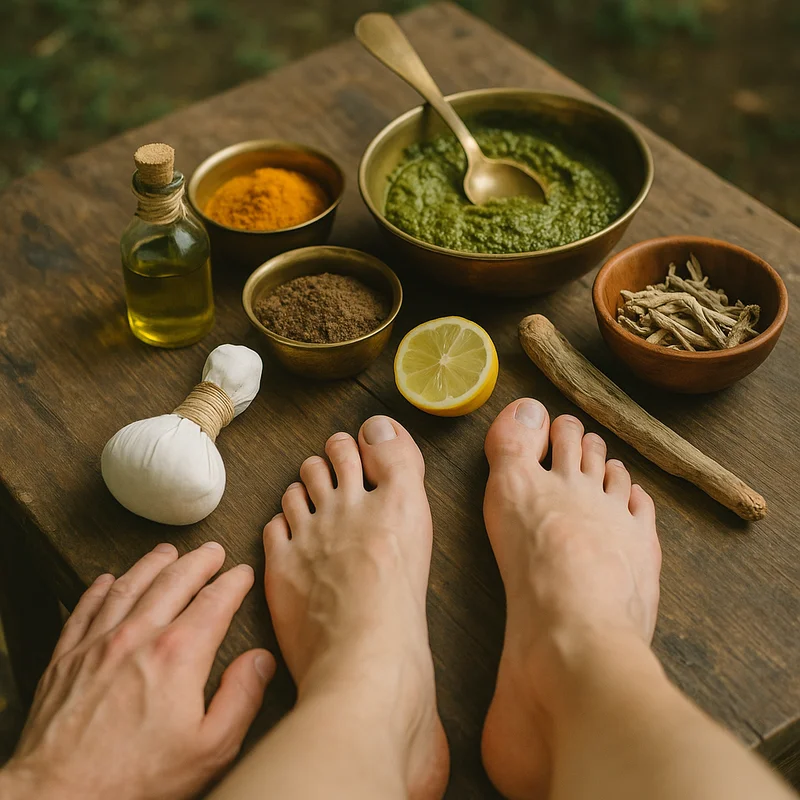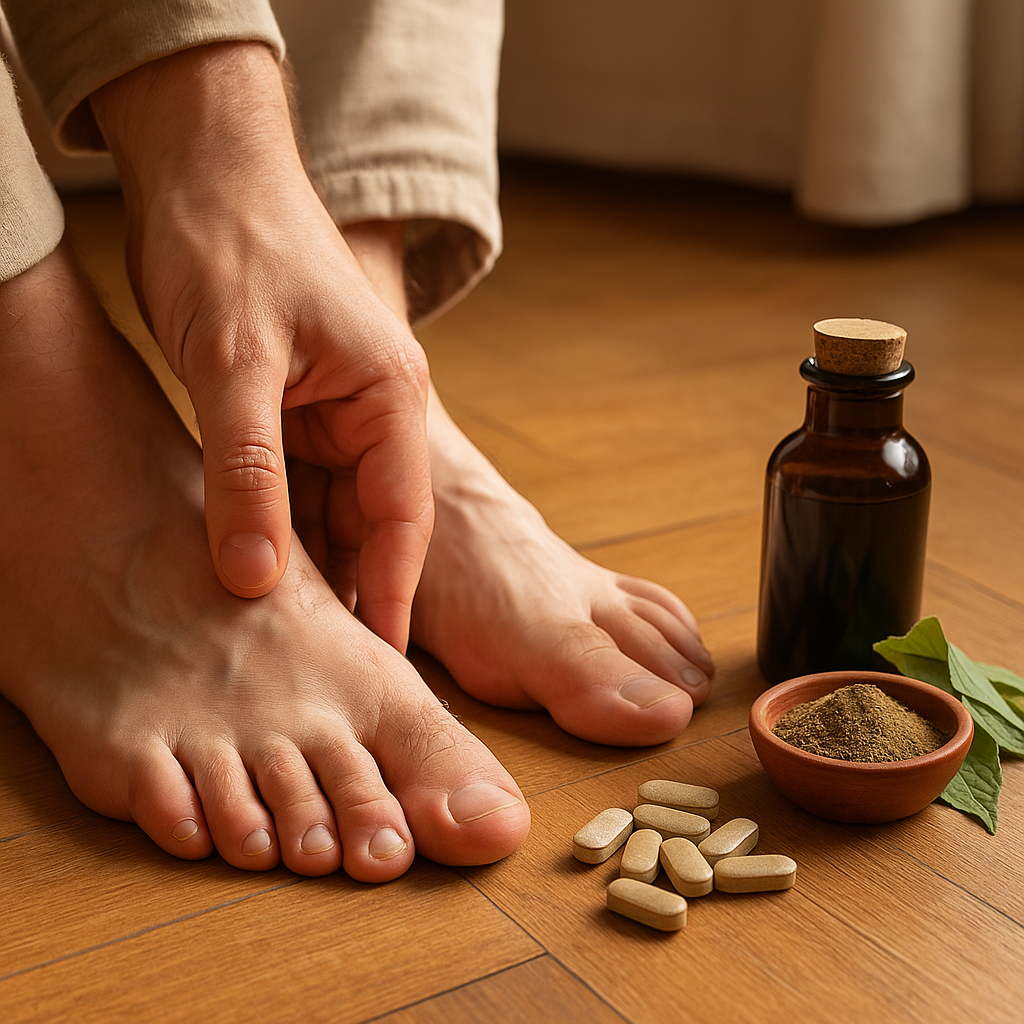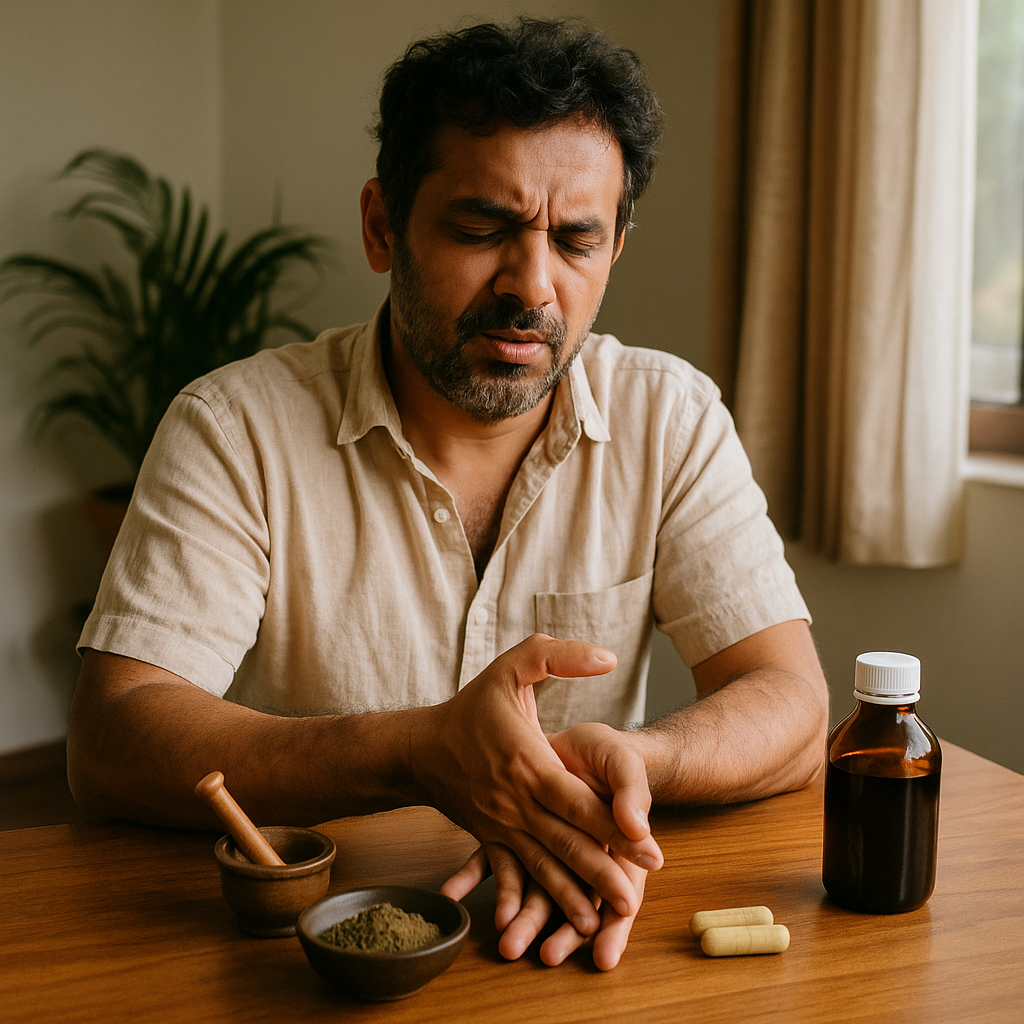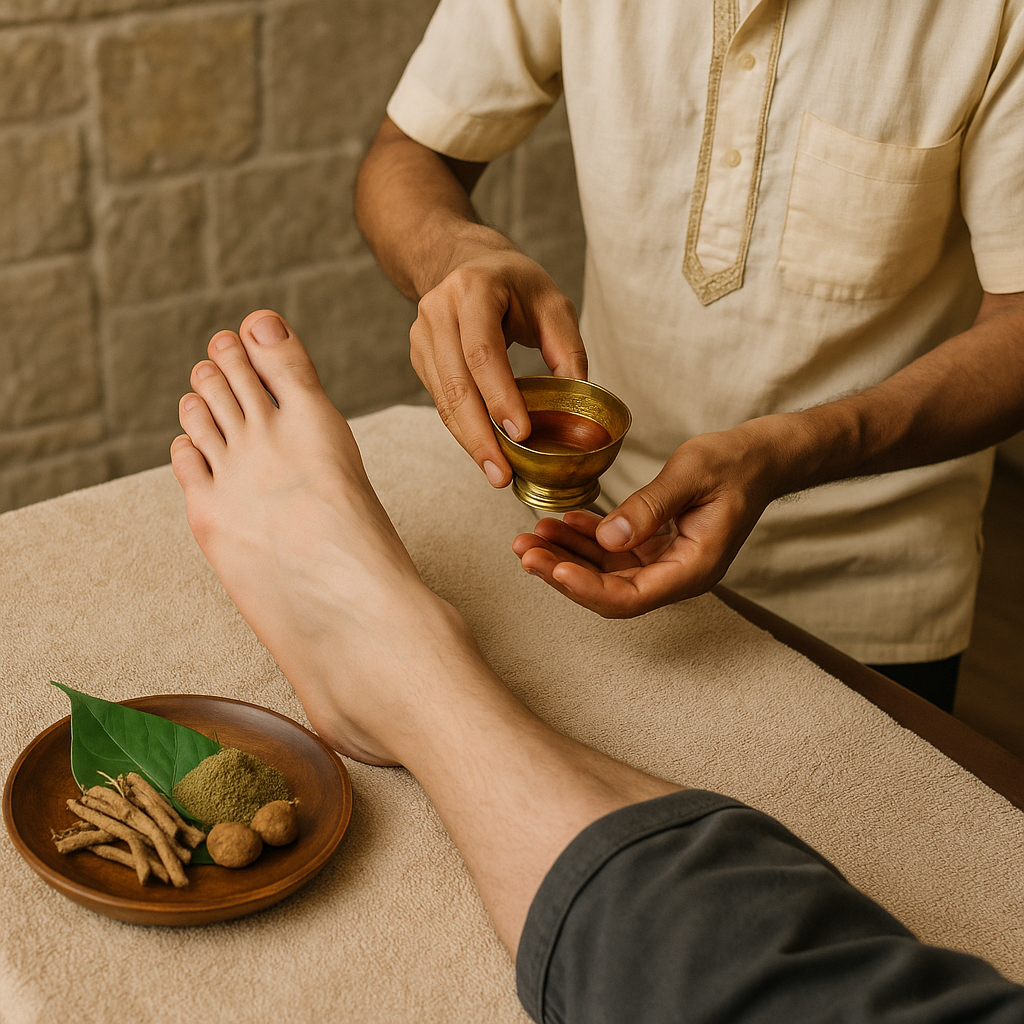Ask Ayurvedic doctor a question and get a consultation online on the problem of your concern in a free or paid mode. More than 2,000 experienced doctors work and wait for your questions on our site and help users to solve their health problems every day.
Shop Now in Our Store
Ayurvedic Medicine for Numbness in Feet: What Really Helps?

Introduction
Let’s be honest—numb feet are annoying. Not in the “mildly inconvenient” way a cold shower is, but in the “is something seriously wrong with me?” kind of way. Whether it's that unsettling pins-and-needles buzz, or just dead, dull silence below your ankles, numbness in the feet has a way of making you acutely aware of something most people take for granted: sensation.
Now, most people run straight to Google or a neurologist when their feet go numb—and fair enough. There could be a lot going on, from diabetes and pinched nerves to circulatory issues. But here's where things get interesting: Ayurveda, the ancient Indian system of medicine, doesn’t just look at numbness as a nerve issue. It sees it as a symptom—a signal from the body that the inner energies (Vata, Pitta, Kapha) are out of whack.
And when you look at it that way, the treatment changes too. It’s not about just popping a pill. It’s about listening. To your habits. To your digestion. Even your emotions. Because according to Ayurveda, everything’s connected—your nerves, your gut, your sleep, your stress levels, your food choices. It all weaves into the state your feet are in right now.
So why read this?
Because the conventional route might help you manage symptoms, but if you’re looking for long-term relief without side effects—if you want to understand what your numb feet are actually trying to say—Ayurveda can offer something radically different. Not just medicine, but a way of living that makes sense when you start seeing the body as a whole system, not just a machine with broken parts.
In this piece, we’ll dig deep into Ayurvedic medicine for numbness in feet, explore causes, herbs, therapies, real-life stories, and even what modern science has to say about it all.
Ready to feel something again?

What is Ayurvedic Medicine for Numbness in Feet?
Definition and Origin of Ayurvedic Medicine for Numbness in Feet
Okay, so let’s first untangle what this even means. When we talk about “Ayurvedic medicine for numbness in feet,” we're not referring to a single pill or miracle root. It's an entire approach—a combination of diagnosis, lifestyle tweaks, herbs, oils, and even mindset changes.
In Sanskrit, numbness is often linked to conditions like “Pada Suptata” or symptoms of Vatavyadhi—disorders born from Vata imbalance (more on that in a bit). Ayurveda views numbness as a sign that prana (life energy) isn’t flowing freely—maybe there’s a block in the nadis (subtle channels), or dryness in the srotas (bodily systems), or maybe even ama (toxic build-up from poor digestion) is clogging things up.
The goal? Restore movement, warmth, and flow.
How? Through medicines made from roots, barks, leaves, and minerals that have been used for centuries—literally thousands of years. Plants like Ashwagandha, Bala, Rasna, or even medicated oils like Mahanarayan Taila, which are massaged deeply into the limbs.
But what makes it different from Western medicine? It doesn’t just say “Oh, you’ve got numb feet, let’s stimulate the nerves.” Ayurveda says, “Let’s figure out why your Vata is aggravated in the first place.”
Big difference.
Historical Use of Ayurvedic Medicine in Treating Numbness
Now this bit’s fascinating. Way back, the ancient Ayurvedic texts—Charaka Samhita, Sushruta Samhita, Ashtanga Hridayam—already described conditions that resemble modern neurological disorders. Terms like “Pakshaghata” (paralysis) or “Suptata” (numbness) were grouped under Vata disorders.
There are records of royal physicians treating these issues using complex combinations of herbs, ghee-based formulations, enemas, and massage techniques. Some of the remedies feel eerily modern—like using oil to calm nerves (hello, omega-3s?) or warming the body to improve circulation.
What’s wild is how precise some of these descriptions were. Sushruta spoke about "loss of sensation in extremities accompanied by stiffness and involuntary movement,” which today might be labeled peripheral neuropathy. But he didn’t stop there—he outlined treatment sequences, including Panchakarma detox, Snehana (oiling), Swedana (steam), and Rasayana (rejuvenative) therapies.
You know, it makes you think: how did they know all this? No MRI machines. No textbooks. Just observation, intuition, and lots of trial and error across centuries.
Cultivation and Harvesting Details (When Applicable)
Here’s where it gets earthy—literally.
Most Ayurvedic medicines for nerve-related issues like numbness draw from herbs that grow in wild, mountainous, or tropical regions. Take Ashwagandha, for example—one of the most respected adaptogens. It's grown in dry regions, harvested in the winter, and its roots are often dried for weeks before being ground into powder. That powder isn’t just thrown into a capsule. Sometimes it’s fermented into a decoction, other times mixed with ghee or honey.
Then there’s Bala (Sida cordifolia), used to strengthen the nervous system. It’s best harvested when the flowers bloom, and often used in oil preparations. Or Rasna, a root known for its Vata-pacifying properties, usually collected from forest edges.
The purity and potency of these herbs depend heavily on when they’re picked, how they’re stored, and whether they’re grown organically. That’s something often missing in commercial Ayurvedic brands that chase volume over value.
So yes, Ayurvedic medicine isn’t just what’s in the jar—it’s how the plant grew, when it was harvested, how it was prepared, and even who prepared it.
Honestly? That kind of care feels almost sacred.
Key Components and Active Substances in Ayurvedic Medicine for Numbness in Feet
Chemical Composition and Active Ingredients
Okay, let’s talk ingredients—not in the cooking sense, but in the “what’s actually in this thing that’s helping my feet wake up” sense.
Take Ashwagandha, for example. It’s one of Ayurveda’s big guns. The active compounds? Withanolides. These are steroidal lactones known to reduce inflammation, promote nerve regeneration, and balance stress hormones. That’s huge, because chronic stress often aggravates Vata, and an aggravated Vata is the usual suspect in numbness.
Then there’s Bala (Sida cordifolia). It contains ephedrine-like alkaloids, which is a fancy way of saying it helps stimulate nerve function and blood flow. That’s why it’s often used in medicated oils for massaging numb areas.
Rasna has potent anti-inflammatory and analgesic compounds—think of it as nature’s ibuprofen, but without the digestive side effects. And Dashamoola, a ten-root combo used in many decoctions, works on multiple tissues at once—nerves, blood, joints, and digestion.
And if you go deeper into formulations like Maharasnadi Kwath, Ksheerabala Taila, or Mahanarayan Taila, you’ll find combinations of dozens of herbs that target Vata at various levels—some herbs calm the mind, others stimulate circulation, and some lubricate the nervous pathways (yes, that’s a thing in Ayurveda).
Basically, these are not “random leaves in a jar.” These are carefully curated chemical cocktails—designed centuries ago and still making sense.
How the Components Affect the Body
Imagine your nerves as little highways. Vata governs movement, so when it’s out of whack, the “traffic” slows, stops, or gets all jittery. That’s numbness. These herbs are like traffic cops, road maintenance teams, and fuel stations all rolled into one.
-
Ashwagandha: Calms down hyperactive nerves and supports adrenal recovery. So if stress or burnout is a factor, this one's a game changer.
-
Bala: Literally means “strength.” It boosts nerve conduction and tones muscle and nerve fibers.
-
Dashamoola: Clears out blocks. Improves circulation, reduces stiffness, and balances excess Vata.
-
Guduchi and Shankhpushpi: These work more on the mental side—clarity, sleep, calming erratic thoughts that worsen symptoms.
What’s really cool is that these herbs aren’t “numbing” your nerves like a painkiller. They’re helping revive them. Ayurveda calls this “nadi-sandhana”—restoring the flow and connectivity of the nerve channels.
Comparison with Similar Ayurvedic Remedies
You might be wondering—what about other herbs? Why not just use turmeric or triphala?
Well, you can, but those are more general-purpose. Turmeric, for instance, is great for inflammation, but it doesn’t directly nourish or lubricate the nervous system. Triphala helps digestion, which supports overall health, but it won’t specifically address neuropathy.
On the other hand, Ayurvedic remedies for numbness are more targeted—they combine deep rejuvenation (Rasayana) with nervous system support and detox.
For example:
-
Ksheerabala Taila is used externally and internally in severe cases. It’s a milk-oil decoction that goes deep into tissues.
-
Yogaraj Guggulu: Excellent for chronic Vata disorders, especially when there’s stiffness or pain along with numbness.
-
Saraswatarishta: Works on nervous tissue but also uplifts mood and memory—great for patients with cognitive fog plus numbness.
So yeah, Ayurveda’s toolbox is vast—but the key is matching the right tool to the specific Vata imbalance causing your numb feet.
Health Benefits and Therapeutic Uses of Ayurvedic Medicine for Numbness in Feet
Physical Health Benefits
This one’s obvious, but let’s say it anyway: the number one benefit is restored sensation. You start feeling your toes again. You don’t wince when you walk barefoot. Your balance improves. You stop worrying that you’ll trip on nothing.
But it’s not just the nerves. Ayurvedic medicine works on circulation, joint mobility, muscular tone, and even digestion—all of which affect how well your body moves and feels.
Some people report improved warmth in the feet (a big Vata win), less tingling at night, and more restful sleep once the discomfort eases.
If you’re dealing with diabetes-related neuropathy, Ayurvedic support can help slow progression and enhance circulation—especially with herbs like Guduchi and Shilajit, which are known to support metabolism and microcirculation.
Mental and Emotional Health Benefits
This is the part that often gets overlooked.
You don’t just feel your feet again—you feel grounded. Like mentally. Vata imbalance doesn’t just cause numbness, it causes restlessness, anxiety, insomnia, and that spaced-out feeling.
When you start oiling your feet with warm sesame oil or taking a daily dose of Ashwagandha, something shifts. You sleep better. You stop feeling so… flighty. That constant buzzing in your head (and your limbs) eases up.
One patient told me, “It’s not just that I can feel my feet again. I can feel myself again.” That’s not medical science. That’s lived experience.
Most Effective Use Cases
Here’s where Ayurvedic treatment shines:
-
Peripheral neuropathy (diabetes, chemo-related, unknown cause)
-
Sciatica with numbness
-
Post-surgical nerve damage
-
Vata-prone individuals (thin, anxious, always cold) with lifestyle stress
-
Elderly folks with declining circulation or “dead feet” feeling
It also works wonderfully as a preventive tool—especially if you’re in a high-risk category and want to avoid medication side effects or invasive procedures.
Use of Ayurvedic Medicine in Integrated Therapy
Here’s the fun part: Ayurveda plays well with others.
You don’t have to ditch your neurologist. But adding Ayurvedic practices—like daily oil massage, warm Vata-pacifying meals, herbal supplements—can boost your overall recovery. I’ve seen people on conventional nerve meds respond better once they introduce Ayurvedic support.
It’s like adding fuel to a half-burning fire. Things pick up. Healing accelerates.
That’s the beauty of Ayurveda as a system—it doesn’t fight modern medicine. It fills in the gaps.

Indications and Contraindications of Ayurvedic Medicine for Numbness in Feet
Health Conditions Where It's Recommended
Ayurvedic treatment is strongly indicated for:
-
Peripheral neuropathy
-
Chronic Vata disorders
-
Sciatica with sensory issues
-
Post-stroke rehabilitation
-
Autoimmune conditions with nerve involvement
-
Old age–related nervous degeneration
Even if your numbness is mild or irregular, early Ayurvedic intervention can prevent worsening. It’s a proactive tool, not just a rescue kit.
Possible Side Effects and Contraindications
This is where people think, “Oh, it's herbal, so it must be safe.” Not always.
-
Ashwagandha might overstimulate if taken in high doses, especially in people with hyperthyroidism.
-
Bala oil can clog pores if overused topically.
-
Formulations with Guggulu are not ideal for people with severe gastritis or heartburn.
-
Some herbs interact with blood thinners or diabetic medications.
And if you’re self-prescribing off the internet—please don’t. Always consult an Ayurvedic practitioner. These herbs are powerful. Respect them.
Restrictions Based on Age, Health Status, or Drug Interactions
-
Pregnant or breastfeeding women should avoid strong Rasayanas unless supervised.
-
Children usually don’t need nerve tonics unless under very specific guidance.
-
Elderly patients might need lower doses or gentler formulations—think decoctions over tablets.
-
People on blood sugar or pressure meds need tailored protocols to avoid hypoglycemia or BP drops.
Again—Ayurveda isn’t “one size fits all.” It’s “exactly what you need at this moment.” Subtle, but powerful.
How to Properly Use Ayurvedic Medicine for Numbness in Feet
Recommended Forms and Dosages
This depends on your constitution, severity, and symptoms. But here’s a general layout:
-
Ashwagandha churna: 3–5g with warm milk at night
-
Bala Taila: For daily foot massage
-
Maharasnadi Kwath: 15–30ml decoction twice daily before meals
-
Yogaraj Guggulu: 1–2 tablets twice daily with warm water
-
Ksheerabala 101: For deeper nerve issues—needs professional guidance
Always start low. Watch how your body responds. Tweak. Ayurveda is intuitive like that.
Best Time to Take It / Dosage Schedule
-
Herbal decoctions: 30 mins before meals
-
Capsules or churnas: With warm milk or water, either morning or before bed depending on formulation
-
Oils: Warmed before application. Massage morning and/or evening. Bonus if followed by warm soak or steam.
Consistency matters. You can’t rub oil on your feet once and expect miracles. Give it 4–6 weeks, minimum.
Recipes and Practical Advice
Here’s one I love:
Vata-Calming Foot Massage Oil (DIY)
-
Sesame oil – 100 ml
-
Dashamoola powder – 2 tbsp
-
Heat together gently for 15 minutes
-
Strain and store in a glass bottle
Massage warm into soles of feet before bed. Cover with cotton socks. Sleep like a log.
Other simple tips? Soak your feet in warm water with dry ginger and rock salt. Avoid cold food. Ditch raw salads for a while. Walk barefoot on warm earth or a wooden floor.
Success Stories and Real-Life Examples (Case Studies)
Not everyone’s into case studies, but let’s be real — stories stick. They’re how we humans learn best.
Case 1: Rajesh, 52, Type 2 Diabetes for 10 Years
Rajesh had what he described as "rubber feet." No sensation, especially in the mornings. Walking barefoot felt like stepping on cardboard. He was on standard diabetic meds, but the numbness just kept getting worse.
He started Ayurvedic treatment under a local vaidya: daily warm oil massage (Ksheerabala Taila), Maharasnadi Kwath, and a diet that was warm, soft, and Vata-pacifying. No raw veggies, no iced drinks. After 6 weeks, sensation slowly crept back in. By 3 months, he could feel the floor again. Not a miracle — just consistent care.
Case 2: Anita, 34, Chronic Stress & Burnout
Anita wasn’t diabetic, but she worked a high-stress tech job and had insomnia. Her feet would go numb during long flights or late nights. Doctors called it “idiopathic neuropathy” (read: they didn’t know why).
An Ayurvedic consult showed high Vata. She started Ashwagandha, Shankhpushpi syrup, warm oil massage, and switched to regular meals with ghee. Within a month, she reported not just better sensation but better sleep and more clarity.
Ayurveda didn’t just fix the feet. It helped her feel whole again.

Scientific Research and Evidence of Effectiveness of Ayurvedic Medicine for Numbness in Feet
Summary of Clinical Studies Supporting It
Ayurveda’s catching attention in research circles, especially for neuropathy. Here’s what’s been observed:
-
A clinical trial at Banaras Hindu University found that Ashwagandha significantly improved nerve conduction velocity in diabetic patients.
-
Bala and Dashamoola oils, used in Abhyanga (massage), showed improvement in peripheral neuropathy in a study at the National Institute of Ayurveda.
-
A 2018 review in the Journal of Ayurveda and Integrative Medicine concluded that Rasayana therapies support nerve regeneration and myelin repair.
That’s not small stuff.
Comparison with Results from Conventional Medicine
Conventional medicine typically offers:
-
Gabapentin or Pregabalin
-
Painkillers
-
Blood sugar control (in diabetic cases)
These can manage symptoms — but they often come with brain fog, dependency, or diminishing returns.
Ayurveda, on the other hand, works slower but deeper. Instead of numbing the nerves, it nourishes them. Instead of silencing the symptoms, it asks: “What caused this? And how do we fix that?”
Different mindset. Different outcome.
Conclusion
Let’s bring it all home.
Numbness in feet is more than a weird feeling — it’s a message. From your body. From your nervous system. From Vata itself, maybe. And while popping pills might quiet that message for a while, Ayurveda asks you to listen.
Through herbs like Ashwagandha, oils like Ksheerabala, routines like Abhyanga, and foods that ground rather than scatter, Ayurveda offers more than relief. It offers understanding. Balance. Recovery from the inside out.
It’s not always fast. And it’s not one-size-fits-all. But if you’re willing to be curious — to take that first step, barefoot or not — it might just be the thing your feet (and your nervous system) have been waiting for.
Need advice tailored to your body?
👉 Get personalized advice about Ayurvedic Medicine for Numbness in Feet at Ask-Ayurveda.com
Frequently Asked Questions (FAQ)
1. Can Ayurveda completely cure numbness in feet?
In some cases, yes — especially if the numbness is due to Vata imbalance, mild nerve compression, or early-stage diabetic neuropathy. Chronic conditions may not be “cured” entirely but can be significantly managed with long-term improvement in sensation and mobility.
2. How long does Ayurvedic treatment take to show results?
Generally, noticeable changes begin within 3–6 weeks. For deeper nerve issues, consistent treatment over 3–6 months may be needed. This includes herbs, diet, lifestyle changes, and therapies.
3. Are there any side effects to Ayurvedic treatment?
When guided by a qualified practitioner, side effects are rare. But self-medicating—especially with high doses or strong formulations—can cause digestive issues or interact with other medications.
4. Can I take Ayurvedic medicines along with allopathic ones?
Yes, in many cases. Ayurveda integrates well with conventional treatments. However, timing, dosage, and specific combinations must be supervised to avoid interactions.
5. Is it safe to use Ayurvedic oils during pregnancy?
Not all oils are safe. Gentle oils like Dhanwantaram Taila may be used with caution, but stronger formulations like Mahanarayan Taila should be avoided unless prescribed.
This article is checked by the current qualified Dr Sujal Patil and can be considered a reliable source of information for users of the site.

